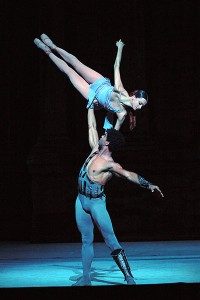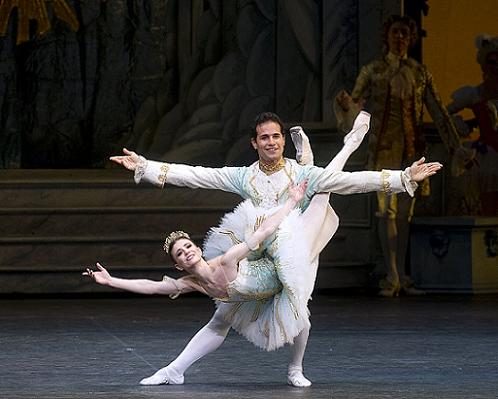The Virtual Pas de Deux – a guide to partnering (part 1)
Here it is, people! As you might have heard, Miami City Ballet-dancer and blog author Rebecca King and I have teamed up, to give you an insight into the world of Pas de Deux, the art of dancing together. For a short introduction to what Pas de Deux is, see this post
What are the essentials a dancer must keep in mind for a successful pas de deux?
HL: First, and most importantly: Be observant, and pay attention to your partner. She’s more important then you are! Make sure she is on balance on her pointe when supposed to, and that you have the control in the lifts to be able to “save the day”, should something go wrong (and it will!). Messing up is normal, that’s why we practice. But if your focus is somewhere else, you are sure to get a mistake coming up, possibly resulting in injuries on your part, or even worse, on her.
 RK: Having an attentive partner makes all the difference in the world. One can always tell when the man radiates an observant attitude. This ensures that you are both on the same page and allows you to feel in-sync.
RK: Having an attentive partner makes all the difference in the world. One can always tell when the man radiates an observant attitude. This ensures that you are both on the same page and allows you to feel in-sync.
HL: Maybe you’ve noticed, ballet is a tad old-fashioned?! Well, it is. The men are strong and stable, the women fragile and soft. While of course a stereotype, there’s something to it. As a partner, you should radiate trust and stability to your partner. Remember, she puts her life in your hands (literarily) when you lift her up there. If you let go, there’s just nothing she can do. She’ll fall, and she’ll fall hard. If you think about it, that’s quite a demonstration of trust in her partner from the girl behind any bigger lift.
RK: It is true! Often the woman’s life really is in the man’s hands. Being able to trust your partner makes everything go more smoothly. As someone who may be considered a bit of a “control freak” if you will, I always tend to have a hard time trusting a partner. This is why it’s important to build a healthy work relationship between the dancers. It allows the woman to relax and place more trust in her partner.
In a company, dancers tend to be partnered together based on height and ability. So naturally, you begin to work with the same partners. Here in Miami City Ballet, I am often cast with the same partners, but I could not be more delighted. We get along very well and are able to communicate in a very productive way. When something goes wrong we discuss it, finding things that each of us could do differently, then try again. This is one of the great things about being in a company for awhile; the relationships you build make working together easier and much more productive.
HL: That’s right. Although the company is full of girls, I tend to work with only a couple of them in every ballet. I’m quite tall (187 cm, or what’s that, 6’1”?!), so that means I “have to” partner the taller girls of out corps. It’s a challenge because, well, longer limbs and bodies means more to coordinate. But as you mention, the consistency of working with one partner can be a great thing – once you get to know your partner’s body and movement, things go way easier.
But this also provides another potential situation – you’d want to stay good with the people you are constantly partnering – there is nothing as devastating as bad vibes between partners.
RK: Definitely. You never know who you will end up dancing with someday, so I always try to be particularly aware of my friendships with the men in the company. Of course I want to be nice to everyone, but I really don’t want to tick off someone who could one day be holding me 7 feet in the air!
HL: I can see the logic in that! ![]()
.
HL: That brings me to the next thing I wanted to talk about: Responsibility. There are many factors that can make an element of the pas de deux go wrong, it may not even be connected to your skills as a partner. Still, for the audience, it’s going to look like the guy’s fault. After all, that’s why he’s there, right?! Girl falls, boy were supposed to catch her. Whattup, dude?
A gentleman-partner takes the responsibility, and doesn’t let his ballerina fall off her pointe, or, God forbid, smack into the linoleum. There are several techniques to prevent this, but in a few words, you can say that a partner can save the situation by doing something else. A big, multiple pirouette might turn into a turn and a pose, an overhead lift might become a fish-dive. Not as spectacular, but sure looks better than the ballerinas teeth cracking on the floor, right?!
RK: Absolutely! I was always taught in school that “It is always the boy’s fault, no matter what!” Of course this is not always true, however, good partners always tend to take the responsibility. In my opinion, I don’t really see the point in placing blame. I find it is best to have a conversation about what went wrong and talk about what can be done to solve a problem.
HL: They teach you that in school?! Man, how mean is that? We kind of just accept that “it’s always the boy”, but that’s all a gentleman-thing! In reality, there are so many factors that can make things not work, on both dancers part. But like you say, in the end, why place blame? The point is to get it better, not to find out who was wrong..
.
As promised, we’re also going to give you a few examples at some basic movements and how to do the technique involved. But keep in mind: dancers practice a lot, with professional supervision. Don’t try this at home!
.
The “Finger Turn”

© Leigh-Ann Esty
RK: A finger turn is when the woman does multiple turns, or pirouettes, with the aid of the man with his arm over her head. The woman faces towards the audience with her right arms above her head (if turning to the right). The man stands behind the woman, also facing to the front with his right hand up and his left arm extended to the side. The woman uses her left hand to push off the man’s left hand. But the real secret is the couple’s right hands. The woman places her fingers together touching the thumb, creating an “o” shape. This is the grasp she uses to turn around the man’s middle finger. But the most important thing for the woman is to not hold the man’s finger, but to keep her “o” shape, allowing for the freedom of multiple turns! This grip is well illustrated in the photo above
HL: Yes, that’s a nice one. And here’s a tip for you guys out there: If you gently press your hand down into hers, she will feel “where you at” better, allowing her to focus on the important part: turning! It also provides a little more friction to use if you need to straighten her up a little – after half a dozen turns, she’s probably going to be all over the place ![]()
.
The “No-handed Fish Dive”

© Gene Schiavone
HL: Now, this is a lift – or actually, it’s more of a pose, because you can’t really take it anywhere – that has a nice trick to it. We call it the no-handed fish dive. It’s cool because, as you might already have guessed, the girl stays up without the boy actually using his hands, which provides a cool how-can-they-do-that-illution.
RK: The girl is ultimately responsible for holding herself up here. Because she has one of her legs in a bent position, her foot ends up being behind the man’s back. To allow the boy to be able to release his grasp on her, she must hug the man with this leg. By “locking” her leg behind him and using her hamstring strength to do so, she then just uses her back strength to keep her upper body facing the audience.
HL: For the boy, this is one of the easiest lifts out there, still it seems extravagant. Make sure you go deep enough with your stance, the flatter the angle of your thigh that she’s resting on, the easier it is to keep. That’s just plain gravity. Otherwise, just hold the position as static as you can, any shaking and twitching is what will make the girl fall forward – her back-muscles are really doing all the job here.
RK: Indeed. But don’t forget about that hamstring; the no-handed fish dive is rough on the muscles of the back of the thigh as well!
.
You like that? Then you’ll be happy to hear that this is just the beginning. The conversation continues on Tendus under a palm tree on Monday, where we’ll discuss what it takes to be a successful partner, what Rebecca and I personally appreciate in a partner (It’s more appropriate than it sounds) and what challenges are involved when dancing a Pas de Deux. We’ll also give you the insight on yet another “trick”, telling you how we perform those fancy lifts. Be sure to Check it Out!
AND BEFORE YOU GO!!
Oh, you thought I was done? No, this post is just filled with surprises. The people that subscribes to my newsletter got the opportunity to ask questions regarding partnering while this post was still in-editing. And they sure did! Actually, they asked so good questions, we decided to do a separate Q&A-post following this one. And that’s good news for all you that didn’t sign up yet: here’s your chance! Do you wonder how the guys can lift the ballerinas with one hand, or how the girls manages to stay in balance all the way up there? Do you have any other questions you’d like two professional dancers to answer? Here is your chance. Post your questions in the comments and we will make sure to include them in the up-and-coming Q&A-post.
Don’t forget to check back to the part two of our introduction to partnering later this week!
Until then,
Ta-Ta
R & H


